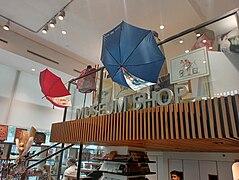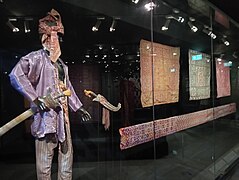
Ayala Corporation is the publicly listed holding company for the diversified interests of the Ayala Group. Founded in the Philippines by Domingo Róxas and Antonio de Ayala during Spanish colonial rule, it is the country's oldest and largest conglomerate. The company has a portfolio of diverse business interests, including investments in retail, education, real estate, banking, telecommunications, water infrastructure, renewable energy, electronics, information technology, automotive, healthcare, management, and business process outsourcing. As of November 2015, it is the country's largest corporation in terms of assets ($48.7B).

Fernando Amorsolo y Cueto was a portraitist and painter of rural Philippine landscapes. Nicknamed the "Grand Old Man of Philippine Art," he was the first-ever to be recognized as a National Artist of the Philippines. He was recognized as such for his "pioneering use of impressionistic technique" as well as his skill in the use of lighting and backlighting in his paintings, "significant not only in the development of Philippine art but also in the formation of Filipino notions of self and identity."

Leandro Valencia Locsin, Sr., also known by the initials LVL and the nickname "Lindy", was a Filipino architect, artist, and interior designer known for his use of concrete, floating volume and simplistic design in his various projects. An avid collector, he was fond of modern painting and Chinese ceramics. He was proclaimed a National Artist of the Philippines for Architecture in 1990 by the late President Corazon C. Aquino.
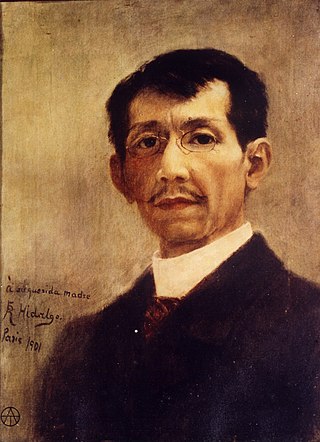
Félix Resurrección Hidalgo y Padilla was a Filipino artist. He is acknowledged as one of the greatest Filipino painters of the late 19th century, and is significant in Philippine history for having been an acquaintance and inspiration for members of the Philippine reform movement which included José Rizal, Marcelo del Pilar, Mariano Ponce, and Graciano López Jaena, although he neither involved himself directly in that movement, nor later associated himself with the First Philippine Republic under Emilio Aguinaldo.
Jaime Zóbel de Ayala y Pfitz, also known as Jaime Zóbel, is a Filipino businessman who served as the chairman of the Ayala Corporation from 1984 to 2006 and as its president from 1984 to 1994. Presently, he holds the honorary title as "Chairman Emeritus".

Ambeth R. Ocampo is a Filipino public historian, academic, cultural administrator, journalist, author, and independent curator. He is best known for his definitive writings about Philippines' national hero José Rizal and on topics in Philippine history and Philippine art through Looking Back, his bi-weekly editorial page column in the Philippine Daily Inquirer.

Don Fabián de la Rosa y Cueto was a Filipino painter. He was the uncle and mentor to the Philippines' national artist in painting, Fernando Amorsolo, and to his brother Pablo. He is regarded as a "master of genre" in Philippine art.
Fernando Zóbel de Ayala y Montojo Torrontegui, also known as Fernando M. Zóbel, was a Spanish Filipino painter, businessman, art collector and museum founder.

The Ateneo Art Gallery is a museum of modern art of the Ateneo de Manila University. It is the first of its kind in the Philippines. It serves as an art resource for the university community and the general public as well. The Gallery is located at the Arts Wing, Areté, Ateneo de Manila University, Katipunan Avenue, Loyola Heights, Quezon City.
Enrique Jacobo Pedro Luis Plácido Zóbel de Ayala was a Spanish-born industrialist and philanthropist who became the first patriarch of the Zóbel de Ayala family. He was also one of the leaders in the Philippine Falange during the 1930s and 1940s.
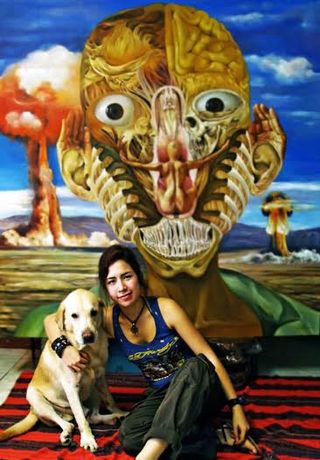
Camille Jean Verdelaire D. Dela Rosa is a painter who studied at the University of the Philippines, Diliman. Her works, commencing in 1998, include Impressionist gardens, landscapes, churches, beaches, and morbid surrealisms.

The Makati Central Business District is a financial and central business district in the Philippines located in the heart of Makati in Metro Manila. It is politically known as "Central Cluster" in the West District of Makati. It is different from the Makati civic center known as "Makati Poblacion" which is situated at the northeast portion of the district. It is bounded by EDSA, Amorsolo Street, Ayala Avenue, Gil Puyat Avenue, Osmeña Highway, South Luzon Expressway, Metro Manila Skyway, Zobel Roxas Street, Ocampo Street, Metropolitan Avenue, Nicanor Garcia Street, Kalayaan Avenue, Makati Avenue, Anza Street, Polaris Street, Orion Street, Mercedes Street, Amapola Street and Estrella Street. The whole district occupies barangays of San Antonio, San Lorenzo, Bel-Air, and Urdaneta.

The Ayala Triangle Gardens is a 2-hectare (4.9-acre) landscaped urban park in Makati, Metro Manila, Philippines. It is a triangular public garden and courtyard in the center of the Makati Central Business District. It was named after its owner and developer Ayala Land, and opened to the public in November 19, 2009. Inspired by Hyde Park in London, the park, which is dotted with palms, acacia trees, and tropical foliage, is considered one of the few "green" areas in Makati.
Anita Magsaysay-Ho was a Filipina painter who specialized in Social Realism and post-Cubism in regard to women in Filipino culture. Magsaysay-Ho's work appeals to Modernism by utilizing more abstract designs and styles rather than realistic approaches. She was the only female member of the "Thirteen Moderns," a standing group of Filipino modernist artists, and in 1958 was chosen by a panel of experts as one of the six major painters of the country's history. The most famous work of Magsaysay-Ho are subject to the beauty of Filipino women dealing with everyday issues. Collections of her artwork can be found in museums around the Philippines.

Purita Kalaw Ledesma was a writer and art critic and founder of the Art Association of the Philippines in 1948.
Wilfredo Beltran Alicdan is a Filipino figurative artist. His works are distinguished by their quaint and geometric folk representations, populated by rounded stylized figures usually engaged in traditional and rural activities.
Celeste Lecaroz-Aceron y Salud, also known as Celeste Lecaroz, is a Filipino visual artist who is known for her works in the spontaneous realism style.

Ramon Nazareth Villegas more popularly known as Mon Villegas or Boy Villegas, was a Filipino curator, art historian, jeweler, author, antiquities dealer, and poet. He was best known for chronicling the history of Philippine art and antiquities in various publications in both the Philippines and overseas. Villegas ran his own antique shop called Yamang Katutubo Artifacts and Crafts, which featured Philippine jewelry and antiques that closed on his death in 2017.
Nena Saguil was a Filipina artist of modernist and abstract paintings and ink drawings. She was most known for her cosmic, organic, and spiritual abstract works depicting internal landscapes of feeling and imagination. For these, Saguil is considered a pioneer of Filipino abstract art.
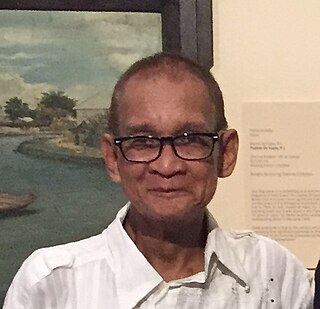
Santiago Albano Pilar more popularly known as Jak Pilar, was a Filipino art historian, curator, and author. He was best known for chronicling Philippine art centered on the 19th and the 20th century in numerous publications in both the Philippines and overseas.









